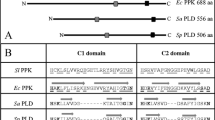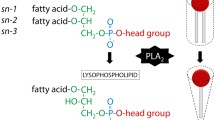Abstract
Ghosts prepared from rat basophilic leukemia cells (RBL cell ghosts) and permeabilized with α-toxin fromS. aureus are a simplified system for the study of FcεRI-mediated activation of phospholipase C (PLC). This activity is dependent upon ATP and magnesium, and is enhanced by the addition of another compound containing an energetic phosphate group, either phosphoenolpyruvate (PEP) or phosphocreatine (PCr). This effect appears to be specific for PEP and PCr in that other compounds with energetic phosphate bonds including fructose 1,6-bisphosphate and additional ATP are not effective. On the contrary, GTP-γ-S, an activator of G proteins, activates PLC in the presence of ATP alone and this is not further enhanced by the addition of PEP. In addition to FcεRI and GTP-γ-S, two other stimuli lead to enhanced activity of PLC in permeabilized RBL cell ghosts: 1) an inhibitor of tyrosine phosphatases (Na3VO4) and 2) an analog of adenosine (NECA). Data presented here extend previous results to show that activation of PLC by GTP-γ-S is not enhanced either by the addition of PCr or by the addition of a more MgATP. Further new findings include the observations that activation of PLC by Na3VO4 is augmented by PEP and PCr in a fashion similar to that observed for FcεRI-mediated activation of PLC and that activation of PLC by NECA shows even more marked dependency on PEP than does activation by FcεRI or Na3VO4. Together, these experiments demonstrate that antigen, Na3VO4, GTP-γ-S, and NECA can all activate PLC in permeabilized RBL cell ghosts in the presence of ATP and that these activities are differentially affected by the addition of a second compound with an energetic phosphate bond.
Similar content being viewed by others
Abbreviations
- DNP25BSA:
-
bovine serum albumin derivitized with 25 dinitrophenyl groups per mole of BSA
- FcεRI:
-
high affinity receptor for IgE
- GTP-γ-S:
-
guanosine-5′-O-(3-thiotriphosphate)
- IPs:
-
inositol phosphate(s)
- K2 Pipes:
-
dipotassium Pipes
- Na3VO4 :
-
sodium vanadate
- NECA:
-
5′-(N-Ethyl)carboxamidoadenosine
- PCr:
-
phosphocreatine
- PEP:
-
phosphoenolpyruvate
- PLC:
-
phospholipase C specific for phosphoinositides
- RBL:
-
rat basophilic leukemia
References
Beaven MA, Moore JP, Smith GA, Hesketh TR, Metcalfe JC: The calcium signal and phosphatidylinositol breakdown in 2H3 cells. J Biol Chem 259:7137–7142, 1984
Ali H, Cunha-Melo JR, Saul WF, Beaven MA: Activation of phospholipase C via adenosine receptors provides synergistic signals for secretion in antigen-stimulated RBL-2H3 cells. Evidence for a novel adenosine receptor. J Biol Chem 265: 745–753, 1990
Liao F, Shin HS, Rhee SG:In vitro tyrosine phosphorylation of PLC gamma 1 and PLC-gamma 2 by src-family protein tyrosine kinases. Biochem Biophys Res Commun 191: 1028–1033, 1993
Benhamou M, Gutkind JS, Robbins KC, Siraganian RP: Tyrosine phosphorylation coupled to IgE receptor-mediated signal transduction and histamine release. Proc Natl Acad Sci USA 87: 5327–5330, 1990
Benhamou M, Siraganian RP: Protein-tyrosine phosphorylation: an essential component of Fc epsilon RI signaling. Immunol Today 13: 195–197, 1992
Eiseman E, Bolen JB: Engagment of the high-affinity IgE receptor activates src protein-related tyrosine kinases. Nature 355: 78–80, 1992
Atkinson TP, Kaliner MA, Hohman RJ: Phospholipase C-gamma 1 is translocated to the membrane of rat basophilic leukemia cells in response to aggregation of IgE receptors. J Immunol 148: 2194–2200, 1992
Atkinson TP, Lee CW, Rhee SG, Hohman RJ: Orthovanadate induces translocation of phospholipase C-gamma 1 and-gamma 2 in permeabilized mast cells. J Immunol 151: 1448–1455, 1993
Beaven MA, Metzger H: Signal transduction by Fc receptors: the Fc epsilon RI case. Immunol Today 14: 222–226, 1993
Adamczewski M, Kinet JP: The high-affinity receptor for immunoglobulin E. Chem Immunol 59: 173–190, 1994
Exton JH: Phosphoinositide phospholipases and G proteins in hormone action. Annu Rev Physiol 56: 349–369, 1994
Deanin GG, Pfeiffer JR, Cutts JL, Fore ML, Oliver JM: Isoprenoid pathway activity is required for IgE receptor-mediated, tyrosine kinase-coupled transmembrane signaling in permeabilized RBL-2H3 rat basophilic leukemia cells. Cell Regul 2: 627–640, 1991
Dreskin SC, Kuhn DE, Huang Y: Phosphoenolpyruvate and creatine phosphate augment ATP and magnesium-dependent, Fc epsilon RI mediated activation of phospholipase C in RBL cell ghosts. J Immunol 151: 3199–3205, 1993
Kuhn DE, Dreskin SC: FcɛRI-mediated hydrolysis of phosphoinositides in permeable membrane vesicles. J Immunol Methods 157: 81–89, 1993
Hardin CD, Raeymaekers L, Paul RJ: Comparison of endogenous and exogenous sources of ATP in fueling Ca2+ uptake in smooth muscle plasma membrane vesicles. J Gen Physiol 99: 21–40, 1992
Ishida Y, Riesinger I, Wallimann T, Paul RJ: Compartmentation of ATP synthesis and utilization in smooth muscle: roles of aerobic glycolysis and creatine kinase. Mol Cell Biochem 133/134: 39–50, 1994
Dreskin SC, Metzger H: Fc epsilon RI-mediated hydrolysis of phosphoinositides in ghosts derived from rat basophilic leukemia cells. J Immunol 146: 3102–3109, 1991
Dreskin SC, Pribluda VS, Metzger H: IgE receptor-mediated hydrolysis of phosphoinositides by cytoplasts from rat basophilic leukemia cells. J Immunol 142: 4407–4415, 1989
Grynkiewicz G, Poenie M, Tsien RY: A new generation of Ca2+ indicators with greatly improved fluorescence properties. J Biol Chem 260: 3440–3450, 1985
Korge P, Byrd SK, Campbell KB: Functional coupling between sarcoplasmic-reticulum-bound creatine kinase and Ca(2+)-ATPase. Eur J Biochem 213: 973–980, 1993
Arrio-Dupont M: An example of substrate channeling between co immobilized enzymes. Coupled activity of myosin ATPase and creatine kinase bound to frog heart myofilaments. FEBS Lett 240: 181–185, 1988
Wallimann T, Hemmer W: Creatinine kinase in non-muscle tissues and cells. Mol Cell Biochem 133/134: 193–220, 1994
Wong K, Cantley LC: Cloning and characterization of a human phosphatidylinositol 4-kinase. J Biol Chem 269: 28878–28884, 1994
Singhal RL, Prajda N, Yeh YA, Weber G: 1-Phosphatidylinositol 4 phosphate 5-kinase (EC 2.7.1.68): a proliferation- and malignancy linked signal transduction enzyme. Cancer Res 54: 5574–5578, 1994
Kihara H, Siraganian RP: Src homology 2 domains of Syk and Lyn bind to tyrosine-phosphorylated subunits of the high affinity IgE receptor. J Biol Chem 269: 22427–22432, 1994
Jouvin MH, Adamczewski M, Numerof R, Letourneur O, Valle A, Kinet JP: Differential control of the tyrosine kinases Lyn and Syk by the two signaling chains of the high affinity immunoglobulin E receptor. J Biol Chem 269: 5918–5925, 1994
Author information
Authors and Affiliations
Rights and permissions
About this article
Cite this article
Dreskin, S.C. ATP-dependent activation of phospholipase C by antigen, NECA, Na3VO4, and GTP-γ-S in permeabilized RBL cell ghosts: Differential augmentation by ATP, phosphoenolpyruvate and phosphocreatine. Mol Cell Biochem 146, 165–170 (1995). https://doi.org/10.1007/BF00944609
Received:
Accepted:
Issue Date:
DOI: https://doi.org/10.1007/BF00944609




